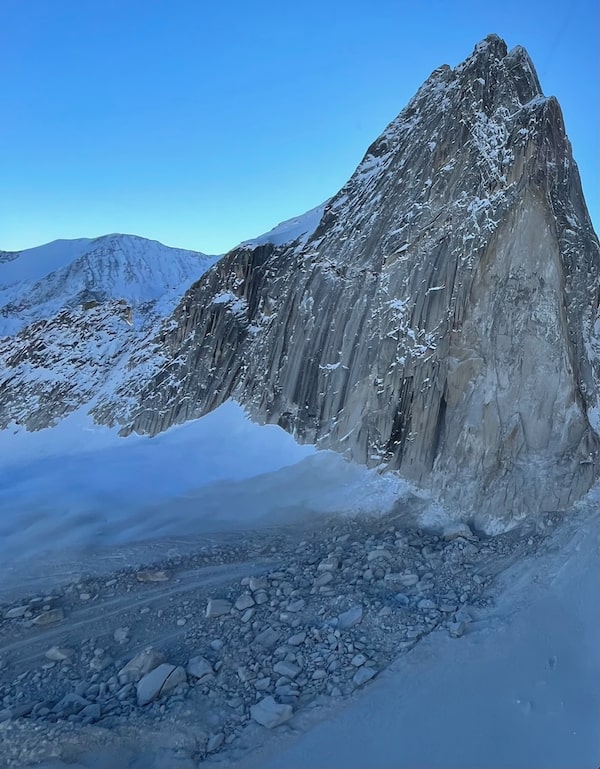
Snowpatch Spire, one of the granite peaks sprouting out of a glacier in Bugaboo Provincial Park, shed part of its northeast face in a landslide last month.James Madden/Handout
The Bugaboos, a mountain range in the Purcell Mountains near the border between British Columbia and Alberta, have lost a defining feature.
Snowpatch Spire, one of the granite peaks sprouting out of a glacier in Bugaboo Provincial Park, shed part of its northeast face in a landslide last month. “The Bugs” are revered among the mountaineering set and the Snowpatch rockfall wiped out nearly two dozen rock-climbing routes, including the well-known Sunshine Crack.
“The Mona Lisa smile just fell off,” said Will Gadd, a professional mountain athlete and adventure guide in Canmore, Alta.
The crash happened some time between noon on Dec. 21 and noon the following day, with mountain-lovers and rock fanatics quickly sharing theories, memories and photos. The precise cause isn’t known – and it may never be – but experts note that such dramatic changes are both natural and also accelerating thanks to climate change. While some alpine enthusiasts may want to rush to Snowpatch and establish new climbing routes, seasoned hands like Mr. Gadd plan to stay away from the fresh scar.
“I want no part of this until five to 10 years has gone by,” he said. “There’s going to be things falling down for a long time.”
Jon Walsh, another world-class alpine athlete from Cochrane, Alta., has spent decades climbing in the Bugs. Snowpatch lost a chunk known as the Tom Egan wall, which Mr. Walsh described as a “massive flake that was totally detached from the mountain.” He added: “It was already just hanging there.”
Snowpatch is about a three-hour hike off Highway 95 between Golden and Radium Hot Springs. During the summer climbing days, hundreds of adventurers make their way up, down and around the spires. Had the landslide occurred then, it could have been fatal, according to climbers familiar with the area. Snowpatch tops out at 3,084 metres.
James Madden, a helicopter skiing guide in the area, photographed the landslide’s debris from above and provided the timeline for the rockfall. He said when the rock hit the glacier, the force pushed a wave of ice in front of it.
“This will make what’s left of this small glacier melt quicker and travel for climbers much harder and more dangerous,” he said in a text message.
The mountain guide said it appears as though “old hard ice,” possibly from the last ice age, behind the flake of rock fell off. Friends Of Bugaboo Park analyzed aerial photos and estimate all or some of 11 routes on the mountain were lost in the landslide.
Drew Brayshaw, a climber who is also a geoscientist with Statlu Environmental Consulting Ltd. in Chilliwack, B.C., estimated that Snowpatch shed between 30,000 and 50,000 cubic metres of rock. After examining the initial photos, he said it appears as though the rock detached along an existing failure plane, on a climb known as Bugaboo Crack.
“It is really hard to say with any certainty why this one particular rockfall occurred, but we can say in general, we know there’s more of these rockfalls recently because of climate change,” he said.

The precise cause of the landslide isn’t known, but experts note that such dramatic changes are both natural and also accelerating thanks to climate change.James Madden/Handout
Alpine permafrost can serve as the glue that holds rocks together, for example. As it thaws, rocks fail. Rapid freezing and thawing can also affect rock stability.
Events from tens of thousands of years ago are also at play.
The Bugaboos are nunataks, mountain summits that poked above the glaciers in the last ice age. The ice was thicker then, exerting pressure on the rocks. As the ice retreats, the rocks can expand. But it takes thousands of years for the stress change to spread through the rock, Mr. Brayshaw said.
Davide Elmo, a professor of rock engineering at the University of British Columbia, posited the Snowpatch landslide is a result of rock bridges that failed. When these types of events happen, scientists analyze how factors such as rainfall and temperature changes may have contributed. Climate change is not necessarily the cause, but a contributing factor to such events, he said.
“Extreme events increase the rate of these failures,” Mr. Elmo said. “But this failure would have happened anyway because it is just geological processes. What we’re doing is we are just accelerating the rate at which they are happening.”
In 2015, a landslide took out chunks of Stawamus Chief Mountain, near Squamish. A series of rockfalls in 2021 built on that earlier slide. In 2019, part of the Howser Spire in the Bugaboos collapsed. That same year, two large landslides on Joffre Peak, in the Coast Mountains, sent an estimated five million cubic metres of rock to the ground.
Dan Shugar, a geomorphologist at the University of Calgary, said that while aftermath of the landslide at Snowpatch Spire looks impressive, it wouldn’t make any list of major events in Western North America.
“Geologically-speaking, it is not actually that big,” he said. “It is probably more culturally important to the alpine climbing community than anything else.”
Indeed, Mr. Gadd, the world-class climber, no longer considers “geologic time” the protective factor he once did.
“Things are changing very fast, globally, in the mountains,” Mr. Gadd said. “For an ice climber, this is an issue.”
 Carrie Tait
Carrie Tait